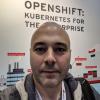It's been just over three years since Solomon Hykes presented the world with the (so far) most creative way to use the tar command: the Docker project. Not only does the project combine existing container-technologies and make them easier to use, but its well-timed introduction drove an unprecedented rate of adoption for new technology.
Did people run containers before the Docker project? Yes, but it was harder to do so. The broader community was favoring LXC, and Red Hat was working on a libvirt-based model for Red Hat Enterprise Linux. With OpenShift 2, Red Hat had already been running containers in production for several years - both in an online PaaS as well as on-premise for enterprise customers. The model pre-Docker however was fundamentally different from what we are seeing today: rather than enabling completely independent runtimes inside the containers, the approach in
OpenShift 2 and libvirt-lxc was to partition the host, re-using the software installed on the host-machine. There were several issues with this model, however, with the most prominent being complexity. Modern deployments are so complex that the process of recreating an application stack (from a puppet manifest, for example) over and over again in dev / test / ops has become too fragile.
This mirrors the problem that we faced with the predominant operational model roughly 20 years ago, when we moved from compiling software on local machines to pre-build binary distribution with rpm. The issue we solved in the “olden days” was that the behavior of a locally compiled application was dependent on the state of the machine at build time and the overhead of this model. We needed binary distribution to achieve a predictable experience of the aggregate software stack.
Today, stacks are so complex and changes in software streams so frequent, that the stack you build is neither what you test nor is what you end up running in production; adding on top of this is the demand for updating applications/systems in place. This brings us back to a situation where the behavior of a production software stack simply becomes dependent on too many variables.
So how do containers, specifically the packaging as provided by the Docker project, marginalize if not outright eliminate these variables? By partitioning and aggregating, of course, which leads to a whole other set of challenges and solutions...but that’s for my next post.
Sobre o autor
Daniel Riek is responsible for driving the technology strategy and facilitating the adoption of Analytics, Machine Learning, and Artificial Intelligence across Red Hat. Focus areas are OpenShift / Kubernetes as a platform for AI, application of AI development and quality process, AI enhanced Operations, enablement for Intelligent Apps.
Navegue por canal
Automação
Últimas novidades em automação de TI para empresas de tecnologia, equipes e ambientes
Inteligência artificial
Descubra as atualizações nas plataformas que proporcionam aos clientes executar suas cargas de trabalho de IA em qualquer ambiente
Nuvem híbrida aberta
Veja como construímos um futuro mais flexível com a nuvem híbrida
Segurança
Veja as últimas novidades sobre como reduzimos riscos em ambientes e tecnologias
Edge computing
Saiba quais são as atualizações nas plataformas que simplificam as operações na borda
Infraestrutura
Saiba o que há de mais recente na plataforma Linux empresarial líder mundial
Aplicações
Conheça nossas soluções desenvolvidas para ajudar você a superar os desafios mais complexos de aplicações
Programas originais
Veja as histórias divertidas de criadores e líderes em tecnologia empresarial
Produtos
- Red Hat Enterprise Linux
- Red Hat OpenShift
- Red Hat Ansible Automation Platform
- Red Hat Cloud Services
- Veja todos os produtos
Ferramentas
- Treinamento e certificação
- Minha conta
- Suporte ao cliente
- Recursos para desenvolvedores
- Encontre um parceiro
- Red Hat Ecosystem Catalog
- Calculadora de valor Red Hat
- Documentação
Experimente, compre, venda
Comunicação
- Contate o setor de vendas
- Fale com o Atendimento ao Cliente
- Contate o setor de treinamento
- Redes sociais
Sobre a Red Hat
A Red Hat é a líder mundial em soluções empresariais open source como Linux, nuvem, containers e Kubernetes. Fornecemos soluções robustas que facilitam o trabalho em diversas plataformas e ambientes, do datacenter principal até a borda da rede.
Selecione um idioma
Red Hat legal and privacy links
- Sobre a Red Hat
- Oportunidades de emprego
- Eventos
- Escritórios
- Fale com a Red Hat
- Blog da Red Hat
- Diversidade, equidade e inclusão
- Cool Stuff Store
- Red Hat Summit

